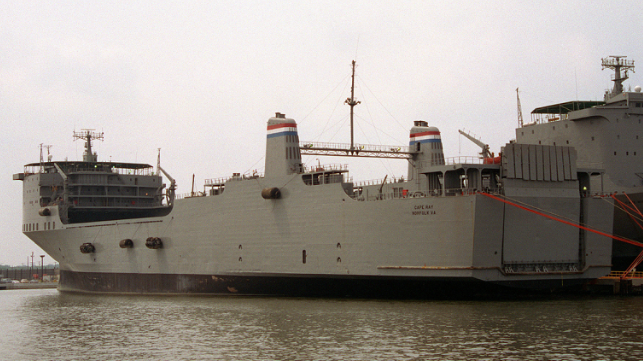Pentagon's TRANSCOM is "Laser-Focused" on Buying Foreign Ships

The U.S. Department of Defense's strategic sealift plans have relied heavily on foreign-built, U.S.-flagged tonnage for decades, and that is not going to change anytime soon, according to U.S. Transcom commander Gen. Jacqueline D. Van Ovost (USAF). Her number one priority is strengthening defense logistics capability in an era of growing competition, and "buy-used" is the fastest, least-cost way to acquire more capacity.
Gen. Van Ovost took the helm at U.S. Transportation Command on October 15, and in her first major speech, she pointed to the growing threat posed by America's potential peer competitors. Transcom is orienting its exercises and preparations for distributed maritime operations in the Indo-Pacific, preparing to counter one increasingly-capable "pacing threat" nation.
“Since World War II, we have enjoyed strategic dominance in [global posture, mobility capacity, and global command and control]," she said. “We now face direct challenges across all domains, threatening our ability to deliver an immediate force tonight, and a decisive force when needed."
The Air Force's air-cargo capacity can deliver an immediate force, but a sustained conflict or a large-scale buildup will require strategic sealift. The Maritime Administration's Ready Reserve Force (RRF) and the Navy's Military Sealift Command surge fleet are designed to deliver relatively rapid mobilization, with about five days of notice - but the Pentagon is all too aware of the limited technical readiness of this fleet.
The mass "turbo activation" exercise for RRF and MSC sealift vessels in 2019 revealed serious weaknesses: six out of 33 ships could not activate in time, and six more experienced "mission impacting discrepancies that would delay an immediate mission tasking." Notably, none of the four Large, Medium-Speed Roll-on/Roll-off ships (LMSRs) in the test completed their operational speed runs at the target speed of 24 knots.
Facing escalating operating costs and declining capabilities, Transcom and the U.S. Navy have a plan in place to recapitalize the fleet and accommodate the mass retirement of some 34-50 of these aging hulls.
"We have too many ro/ros that are getting old, and they're too costly to maintain. Our readiness numbers are a lot lower than I would like," Van Ovost said. "[We're] laser-focused on emphasizing a responsible ‘buy used’ strategy with the U.S. Navy . . . We have limited resources, and we have to get the best capability we can for the nation."
This strategy is well under way. Working with the Navy, the Maritime Administration has already contracted for a third-party "buy-used" program that will acquire foreign-built ro/ros, reflag them into the U.S. and refit them to meet U.S. standards - all at a set package price. That agreement was briefly delayed due to a procurement dispute, but it is now going forward.
In her speech, Van Ovost also highlighted a recent Transcom study of sealift fuel tanker capacity. The study provides new support for a plan to subsidize the U.S.-flag product tanker fleet, in the same manner as the Maritime Security Program (MSP) for foreign-built, U.S.-flagged, U.S.-crewed cargo ships. At present, only two tankers are enrolled in the 60-vessel MSP fleet. The study "clearly demonstrates the need for a Tanker Security Program as a strategy to increase U.S.-flag tanker capacity and ensure that the Department of Defense has sufficient tanker capabilities to meet our national security objectives," Van Ovost said.
The FY2021 Defense Authorization Act incorporated language to create a Tanker Security Program, and the FY2022 MARAD budget request includes $60 million to launch and fund it.
